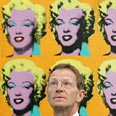
“Does art imitate life, or does life imitate art?”
The question was posed by American artist Andy Warhol.
Warhol was probably not asking the question as much as he was making a statement about the power of communications.
Yet the power of Warhol’s point often escapes everyday minds. It could be the answer to the Palestine-Israel conflict.
We see examples of Warhol’s words In American society, trends and even public opinion driven by the news media that includes not just journalism, but also entertainment and information.
Too often, we view communications in a very narrow perspective but we have to view it in its broadest form of art, TV, cinema, newspapers, magazines, radio, television and public speaking. Communications takes many forms.
One of the most powerful has been the communication of television. Before I explain how we can use TV to change the paradigm of the Arab-Israeli conflict, let’s examine TV for a moment first.
Power of television and media
The news media is driven by negative news and tragedies that reflect what the public really wants to pay to know. They claim they want good news but in reality they only buy newspapers when headlines are filled with tragedy and human suffering.
“If it bleeds it leads” is the driving mantra of the news journalism business.
That creates more tragedy because the audience is conditioned to learn that relationships are built on conflict, rather than on trust.
When TV was invented in the 1950s for most Americans and the 1960s for the rest of the world, it had the greatest impact on human beings both in a good and a bad way.
It opened our eyes to things we could never have imagined, and closed our minds on issues of race. It creates hope and it feeds fears.
We don’t control it the way we should. We take it for granted and sit in front of it as a time babysitter. But TV can be the ultimate peacemaker, not just for society as a whole but Arabs and Israelis.
If we set out to use TV not as a means of financial profit but to line the pockets of goodwill, we can change human conduct, including the way Arabs and Israelis see each other. Combined with humor, goodwill and the vision of a genuine peace between Arabs and Israelis, we can use TV to change paradigms, societies and even ease tensions.
Warhol meets Shahrazad
America is driven by the power of television. Most Americans schedule activities using the calendar of television. What they do and don’t do is based on which programs are broadcast on television.
American TV is divided into seasons. Each season offers new programs at specific times and dates. These TV shows drive American habits and even thinking on major social issues such as “Can a woman be elected president of the United States?”
Public opinion today is leaning toward “Yes.” And that is quite a change from a few decades ago when the idea of a woman running for vice president was seen as challenging, as was the idea that a Catholic could be president.
So TV programs determine how we, as Americans, conduct ourselves. How we plan our lives and even how we think.
More importantly, TV can be used to intentionally manage those perceptions.
TV programs are like soap operas. The original soap opera was devised by a young woman thousands of years ago who lived in the harem of a fearsome Sheik.
“A thousand and one Arabian Nights” was in essence a soap opera of stories that led from one thought to another, intended to manage the audience in a positive way.
Shahrazad managed what was in her time the most powerful form of media and communications, the art of the face-to-face, spoken word. Her stories represented the first soap operas, designed to manipulate the Sheik into keeping her alive so she could tell the next story the next day.
Storytelling that grabbed attention using the most modern form of communications, designed to prevent violence and manage life. Let life imitate the peaceful purposes of well-intentioned, managed art.
Let life imitate the art of peace
What we need in the Middle East is to apply this power to Arabs and Israelis.
We’re in a conflict that only gets worse because our lives are driven by the everyday events of the conflict we see played out in the news media and on TV.
Events control media coverage. Media coverage provokes anger. Anger provokes violence. Violence feeds hate.
Why permit “art” to imitate events that are out of control? Why can’t life imitate art, something we can control?
We need a TV show that Palestinians and Israelis will want to watch. Something they look forward to everyday. Something based on the concepts of Warhol and Shahrazad to drive audiences toward reason and calm.
We can change the perceptions of young minds and avoid the sniping that goes back and forth. Israelis assert Arab TV teaches hate, ignoring evidence of their own hatred. Palestinians defend anything, including the indefensible, such as suicide bombing.
It’s a vicious circle. The only people benefiting are the extremists who feed on conflict. If the Middle East conflict were resolved, the extremists on both sides would be unemployed. But they prefer endless conflict rather than resolution.
Let’s create an industry of hope with a TV show that grabs the attention of both Arabs and Israelis and that teaches them to overcome their tragedies together, using humor and hope.
The answer is within us, but too many of us have given up.
Our governments and political leaders can’t change things. They tried and failed.
Why not try the power of communications? The power of television combined with the power of humor and apply the theories of Andy Warhol and Shahrazad?
I’d watch that TV Sitcom everyday.
(Ray Hanania is an award winning journalist, author and standup comedian. He can be reached at www.hanania.com.)















